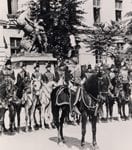The Badminton Blue Danube
Unlike its sister 2nd Battalion, 1st Royal Gloucestershire Hussars had not seen service overseas during the Second World War, but had been used for home defence and as an armoured training regiment. With the end of the war in Europe they began training for the war against Japan but, to their disappointment, their services were not required after the dropping of the atomic bombs. 2nd Lieutenant George Brown had joined the regiment in the summer of 1945 at Bury St Edmunds:-
“The regiment was equipped with Churchill tanks, many of them with flamethrowers fixed at the front of the tank, next to the driver. There were also two troops of light Stuart tanks for reconnaissance, one troop commanded by Ralph Carr-Ellison and one by myself. Intensive battle training culminated in live ammunition exercises on Thetford Battle range.
“We had reached a high state of training and expectation when we heard that the atom bomb had been dropped and peace was declared. We were heartbroken!”
Instead, in December 1945 they were sent to Austria as part of the British Army of Occupation, with Shermans replacing their Churchills and Churchill Crocodiles, and assigned as the Divisional Cavalry Regiment of 46th Division. The long journey took them through Italy through to Graz from where the squadrons were dispersed over a wide area. The winter months were spent in felling and delivering large amounts of lumber to fuel Vienna; ski-ing (being trained by former German army ski instructors); and various other more frivolous activities. The cavalry traditions of the Regiment were not forgotten either, as the Regimental Newsletter of January 1946 described:-
“A small establishment of 20 horses has been allowed, partially for recreational purposes, partially as they may be useful for patrolling the more inaccessible places when the weather is again open.
“These horses we took over from the 10th Hussars and, since then, have another 15, some useful animals amongst them, which the Colonel obtained from the North Irish Horse. If there is racing in the summer we should have some useful entries.
“We are planning a regimental horse Show to select our entries for the Divisional events, which will be followed by an international show in Vienna in late July. At the moment, the horses are all kept as a troop at Piber, three miles from R.H.Q. Novices’ riding courses are being organized, and already 40 men who have hardly ever ridden before have reached a stage when they are jumping and can ride with fair confidence. We are lucky in having the large covered riding school where the Grey Lipizanas [sic] used to be trained, Piber being the original stud farm for the Vienna Spanish High School.”
British soldiers wandered far and wide over the countryside, sightseeing as well as being engaged in more serious work. One group of the Royal Gloucestershire Hussars got as far as Prague, and received a rapturous welcome from all whom they met there, the citizens of Prague being fearful of the prospect of Communist rule, and expressing their heartfelt conviction that Czechoslovakia belonged to the democratic West. But the focus of everyone’s attention was upon war-torn Vienna, with Russian, American, British and French soldiers everywhere, and was described by a hussar of the RGH Recce Troop:-
“Though the war has left a never to be erased mark on Austria’s capital, though the Viennese see Allied flags flying all over their great buildings, one feels and I think hopes that some day Vienna will be gay again. During their leisure time members of the detachment found their entertainment well catered for, and there were several excellent canteens. It was strange to stand before the rather unimposing exterior of the Theater an der Wien and realize that the first performance of Beethoven’s “Fidelio” was given there.
“We visited the Danube and found it, in winter, desolate, and belying its description, a grey brown in colour.
“As might be imagined, Strauss is heard everywhere, but also are sung typically Viennese suburban folk songs. These (Wienerlied) have no counterpart in England at all, and at times are light hearted and sad, but always pleasing to hear.”
British Headquarters was at the Schonbrunn Palace in Vienna, and several military displays were held there during the British Occupation, the monetary proceeds going towards the children of Vienna, providing them with holidays. At the July Tattoo of 1946 the mounted detachment of the Royal Gloucestershire Hussars, in full dress and equipped with lances from which pennons fluttered, performed the intricacies of their Musical Ride to an appreciative audience.
The sight of foreign hussars in full dress as part of an occupying army was something that had not been seen at the heart of the old Habsburg Empire since Napoleon’s troops had passed though in 1809. Then, the citizens of Vienna had turned their backs upon the showy parades of their conquerors, but this time it was different. The fashion for hussars that had begun in the Holy Roman Empire of Austria and Hungary, that had been taken up throughout Europe in the 18th century, and that had been hesitantly adopted in the United Kingdom during the Napoleonic Wars, had come full circle.
Picture: Captain Charles Risby at the head of the Royal Gloucestershire Hussars in front of Schonbrunn Palace.


